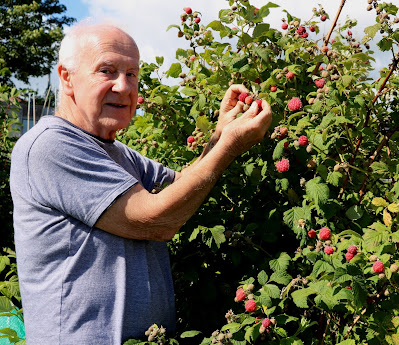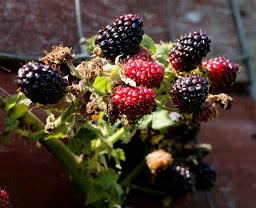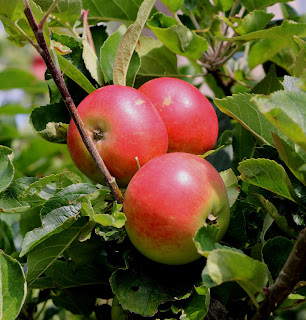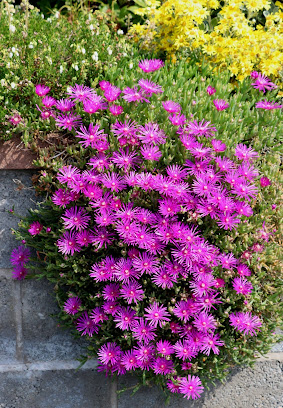BACK TO THE GREENHOUSE
| Add caption |
Plants
under glass have been protected from thunderstorms and gales, but
those that started off with protection, then spent summer outdoors
have had a more turbulent time.
Cape gooseberries growing fast under
glass got a bit big in their large pots so they went outdoors against
a south facing wall. This was great on sunny days, but then came the
thunderstorms.
John picks Solaris grapes
They survived and are now over four feet tall and
still growing and producing a good crop, but it will be a few more
weeks before the first ones ripen. Pepper Early Jalapeno were
plentiful from seed sown early February, so some were planted in
south facing sheltered spots outdoors, some in pots on windowsills
and a few in a border in the greenhouse. It is the ones on the
windowsill that are growing 
Pepper Early Jalapeno
and cropping the best, though it is still
early to judge. Basil grown from a spring sowing indoors grew
strongly at first under glass but suffered when we got a run of cold
gray weather in mid August.
Some in the greenhouse started to rot
off, but those again on my windowsills at home were quite happy. Had
to keep pinching out flower heads to produce more growth. Another
plant getting sown this month in the greenhouse is the onion Senshu
Yellow. Seeds were sown in cellular trays in mid August as weather
had turned cooler and gray skies with mist over the Tay predominate
for several days. I hope to plant the young seedlings in autumn for
over wintering then grow strongly to give an early crop next year.
The first tomatoes were ripe for picking in mid July, then in August both red cherry, Super Sweet 100 and yellow cherry, Sungold and maincrop Alicante were ripening up fast. Anna soon found a tomato soup recipe as we had plenty surplus fruits. Onions, basil, parsley, garlic and oregano and rosemary herbs were added. As we had family visiting from Glasgow it was a large pot of soup, and though it went down very well there
 |
| Tomato Alicante |
was still some left for another day and the freezer. Tomato plants have all reached the greenhouse roof so tops have been removed with most producing five to seven trusses. Cherry tomatoes are so much more vigorous than the Alicante, but the fruits are just heavenly as a frequent snack between meals and in all salads.
 |
| Grape Seigerrebe |
Sunny warm days this year have brought on the greenhouse grapes a lot earlier than last year, so Seigerrebe grapes were quite sweet by mid August. To grow healthy vines under glass good ventilation is very important so all roof vents have been fully open as well as the door. However our local blackbird popped in to have a look around and took a liking to the grapes. He got through several bunches of Seigerrebe before I spotted him. Next year the door and vents will get net protection, but this year I decided to harvest both Seigerrebe and the sweet white muscat flavoured Solaris. As these grapes have pips they are perfect for wine but not for eating unless you are happy to swallow pips. After harvesting work starts immediately, so grapes were separated from the bunch, then crushed in a fermentation bucket with a couple of campden tablets to sterilise any wild yeasts. The following day I add AW4 wine yeast, pectolase, acid, tannin and nutrient. The mixture stays in the bucket for four days then is strained off the must and the wine transferred to demijohns after adding some grape concentrate for further fermentation. If Blackie had stayed away, grapes would have been left on the vine for another week to increase sugar content, but they only had enough for 9% alcohol, so needed some grape concentrate to raise alcohol levels up to 12%
 |
| Field beans green manure crop |
Wee jobs to do this week
As
some mid season potatoes have been lifted the land is now clear for a
green manure crop. Other
early harvested crops of onions, broad beans
and peas left land free for autumn salads, so now as there is still
time for plants to grow, it will be tares, ryegrass, clover or field
beans for my green manure crop. These usually germinate quickly, grow
fast as they all have a strong root ststem. They can get trampled
down in winter then dug in. If field beans grow too tall, they can
get pulled out and chopped up for the compost heap. This still leaves
most of the nodules with nitrogen fixing bacteria in the soil. When
these rot down they will release nitrogen for the spring crops.
END




















